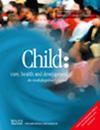Play Together? Unveiling Facilitators and Barriers to Inclusive Outdoor Play for Dutch Children With and Without Disabilities: A Qualitative Study
Abstract
Background
The ‘Right to Play’ is included in the United Nations Convention on the Rights of the Child. Outdoor play contributes to children's overall development, physical and mental health and quality of life. Unfortunately, children with disabilities often experience restrictions while playing outdoors. Understanding children's perspectives is crucial to effectively support them in participating. Our aim was to explore facilitators and barriers perceived by Dutch children with and without disabilities (6–12 years), in regular and special primary education, for participating in inclusive outdoor play.
Methods
We conducted 40 semi-structured interviews in school-aged children (mean age years 8.7, SD 1.9): 22 without disabilities, 10 with disabilities attending regular education and 8 with disabilities attending special education. We transcribed all interviews verbatim, and two independent researchers analysed the data using an inductive thematic approach.
Results
We identified three main themes: personal factors of children with and without disabilities, interacting factors and environmental factors. Each theme has sub-themes acting as either facilitators or barriers to inclusive outdoor play. Personal factors include being open to playing with each other, coping with disabilities, experiencing autonomy, insufficient knowledge about disabilities and feelings about physical and social limitations. Interacting factors include growing up together, making contact and adapting ways of playing. Environmental factors include parents, play environments, communities and time constraints.
Conclusions
Children with and without disabilities in regular and special primary education identify facilitators and barriers in personal, interacting and environmental factors for inclusive outdoor play. Children with disabilities encounter more barriers than those without disabilities. All children are open to playing together, and paediatric rehabilitation professionals and parents play a crucial role in facilitating positive play experiences early on, providing knowledge about the consequences of disabilities, showcasing the capabilities of children with disabilities and collaborating to adapt playgrounds.


 求助内容:
求助内容: 应助结果提醒方式:
应助结果提醒方式:


